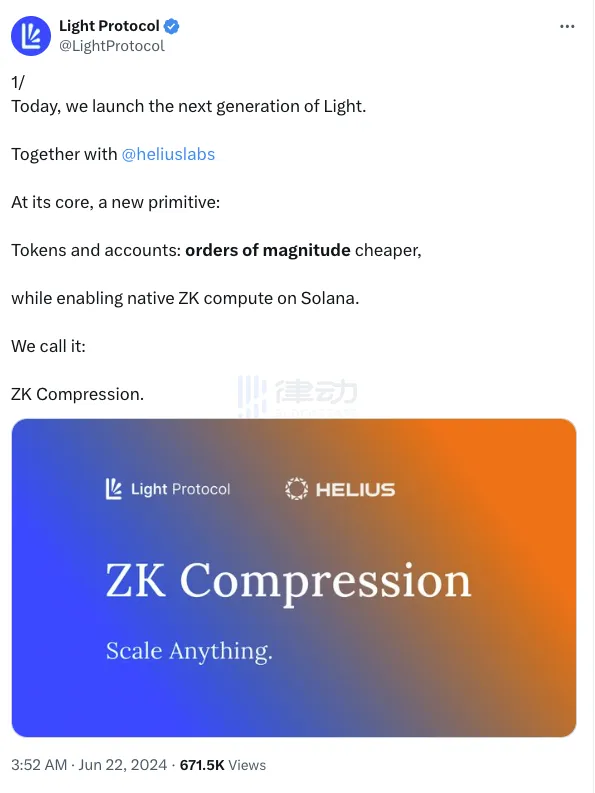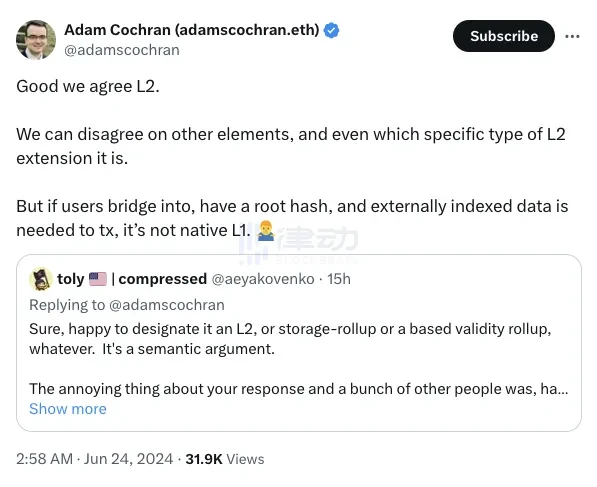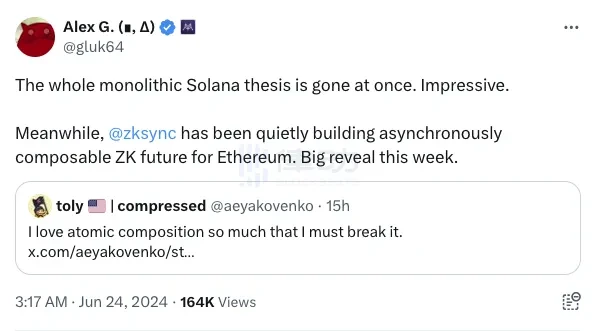Solana lance ZK Compression, la communauté Ethereum a-t-elle été brisée ?
Solana et la communauté Ethereum se disputent à nouveau, cette fois à propos de la technologie de compression ZK récemment lancée par Solana.
Hier, Mert Mumtaz, PDG de la plateforme de développement de l'écosystème Solana Helius, annoncé sur la plateforme X que ZK Compression est introduit dans Solana. Peu de temps après, le projet de confidentialité de l'écosystème Solana Light Protocol a annoncé le lancement de Compression ZK. Selon Mert, la compression ZK sera effectuée directement sur L1 sans L2, ce qui améliorera considérablement l'évolutivité du réseau Solana et fera un pas en avant vers la construction d'un ordinateur financier - une machine à états atomique globale et imparable synchronisée à la vitesse de la lumière.

Selon la compression ZK documentation , la technologie est une nouvelle primitive construite sur Solana qui permet aux développeurs de créer des applications à grande échelle. Les développeurs et les utilisateurs peuvent choisir de compresser leurs états en chaîne, réduisant ainsi les coûts d'état de plusieurs ordres de grandeur tout en maintenant la sécurité, les performances et la composabilité de Solana L1.
La compression ZK fonctionne grâce à un processus appelé compression d'état, qui permet aux développeurs d'utiliser l'espace de registre moins cher de Solana au lieu de l'espace de compte plus cher pour stocker certains types de données. Les hachages ou les empreintes digitales des données hors chaîne sont stockés sur la chaîne pour vérification à l'aide d'arbres d'état clairsemés.
La communauté Ethereum est-elle en panne ?
Une explication purement technique peut être trop compliquée, mais pour le dire simplement, cette technologie réduit le coût de l'État de Solana.
Dans Solana, les techniciens sont confrontés à deux coûts : le coût de calcul et le coût d'état. Solana dispose actuellement d'une puissance de calcul bon marché, mais l'état est cher. L'attribution de comptes, le paiement d'un loyer et l'évolutivité avec les utilisateurs se sont avérés être d'énormes obstacles pour les développeurs de Solana, et ZK Compression résout ce problème.
Mert a utilisé le coût des parachutages comme exemple, en supposant que les parachutages soient effectués auprès d'un million d'utilisateurs, le coût pour l'État serait réduit de plus de $260 000 à $50, ce qui est 5 200 fois moins cher. Justin Bons, fondateur et DSI de Cyber Capital, a également déclaré : croit que la compression ZK place clairement Solana loin devant ETH en termes d'évolutivité L1 réelle, résolvant l'un des plus gros problèmes de survie de Solana.

Les opinions exprimées par Justin Bons ont mis mal à l'aise la communauté Ethereum, qui était coincée dans le problème de l'expansion et s'est tournée vers le rollup. Ils ont remis en question la nature L1 de la compression ZK.
Depuis que Mert a déclaré que les données de compression ZK sont conservées hors chaîne, la communauté Ethereum les considère comme valides. La communauté Solana a répondu avec un mème, se moquant du fait qu'ils prétendent être des experts sans faire de recherches sérieuses. Mert a même nommé ZK Compression ZK valide par dépit.

Afin de convaincre la communauté Ethereum, Mert a nommé le fondateur d'Ethereum, Vitalik, sur Farcaster et lui a demandé de commenter les principes techniques de la compression ZK. Vitalik a également répondu sérieusement et a déclaré que la technologie ressemble davantage à une architecture client sans état.
Vitalik interprète la compression ZK en 3 points principaux. Tout d'abord, vous avez une nouvelle classe de comptes, pour lesquels seul le hachage de leur état est stocké sur la chaîne. Deuxièmement, pour interagir avec ces comptes, vous devez écrire un TX qui spécifie le hachage pré-état et le hachage post-état de N comptes et fournit une preuve de validité (en supposant que cela signifie ZK-SNARK). Troisièmement, le nouvel état doit être public (ce qui est logique, sinon vous pouvez envoyer au hasard une somme d'argent à quelqu'un et son compte sera inaccessible. Vous pouvez contourner cela et en faire un système Ut xo, mais ce serait une limitation importante).

Outre l'interprétation, Vitalik a également soulevé des questions sur le document. D'une part, il s'agissait de la preuve de validité de 128 octets mentionnée dans le document et, d'autre part, de savoir si le contenu public incluait le contenu transactionnel.
Plus tard, Vitalik a de nouveau exprimé ses doutes. Il pensait que les chiffres revendiqués par ZK Compression étaient tels que s'ils étaient effectués séparément à chaque fois, le coût de la vérification de SNARK serait plus élevé que le coût de certaines petites actions et opérations de hachage (comme les transferts de jetons). Les avantages du rollup ZK proviennent d'un seul SNARK regroupant de nombreuses transactions.

Mais la question de Vitalik n'a pas reçu de réponse, et sa description initiale de ZK Compression comme une architecture client sans état a donné plus de confiance aux partisans, y compris Mert.
Adam Cochran, partenaire de CEHV, a fermement déclaré que la compression ZK est la solution L2 de Solana et il pense qu'un jour, les membres de Solana se rendront compte que ce qu'ils ont construit est un bon rollup basé sur la fonctionnalité/validité L2, et non une chaîne complète. L'attitude ferme d'Adams a également suscité des critiques de la part de Mert.
Anatoly Yakovenko, cofondateur de Solana, semblait « indifférent » au débat sur L1 ou L2, et a même déclaré qu'il était « heureux de le désigner comme L2, cumul de stockage ou cumul basé sur la validité, etc. » Il a simplement souligné que « toutes les exécutions se produisent sur L1 et sont ordonnées par les validateurs L1. » Bien qu'Adam ait été différent de la réponse dure de Mert, il a quand même insisté sur le fait que la compression ZK ne pouvait pas être L1.

Alex Gluchowski, fondateur de ZKsync, était également critique de ZK Compression. Dans le même temps, il a déclaré que ZKsync construisait tranquillement un avenir ZK asynchrone et composable pour Ethereum. Mais il est intéressant de noter qu'après la sortie de ZK Compression, Anatoly a également publié un long article présentant l'exécution de programmes asynchrones (APE) dans Solana.

Rollup sera-t-il le partenaire idéal pour Solana ?
Solana a cherché à valoriser son réseau. La logique de valorisation des altchains issues du dernier marché haussier n'est pas exactement celle de Bitcoin et d'Ethereum. En raison de l'espace de bloc bon marché, il est difficile que les prix des pièces correspondantes augmentent de manière significative. Cependant, Solana se concentre toujours sur la technologie de compression et réduit constamment ses coûts, ce qui constitue dans une certaine mesure un énorme défi pour l'appréciation de SOL.
Même en prenant en compte la loi de Moore, même si le matériel continue de s'améliorer en termes de performances et que Solana est optimisé pour ces progrès matériels, cela ne signifie pas que Solana sera en mesure de gérer la demande mondiale, mais Solana s'en sortira mieux que les autres chaînes en termes de dépendance à la composabilité et de faible latence.
Contrairement à Ethereum, le réseau principal Solana n'a pas vocation à être une « chaîne B2B » ; il a toujours été et sera toujours une chaîne de consommation. La création de systèmes distribués à grande échelle est extrêmement difficile, et Solana a le meilleur potentiel pour devenir le registre partagé des transactions les plus précieuses au monde.
En ce qui concerne les rollups, les rollups Solana seront principalement abstraits pour les utilisateurs finaux.
Idéologiquement, le roll-up d'Ethereums était descendant, c'est-à-dire que la Fondation Ethereum et les dirigeants ont décidé que le meilleur moyen de se développer était par le biais de roll-ups, puis ont commencé à soutenir divers Layer 2 après l'incident des CryptoKitties. Dans Solana, la demande est ascendante, c'est-à-dire de la part des développeurs d'applications avec une adoption significative des utilisateurs. Par conséquent, la plupart des jeux de roll-up actuels sont des jeux marketing, qui sont davantage axés sur le récit que sur la demande des utilisateurs. Il s'agit d'une différence significative qui peut conduire à un avenir de roll-up différent de celui d'Ethereum.
Mais la compression d'état que ZK Compression permet pour Solana, combinée à Firedancer, à plusieurs leaders simultanés, à l'exécution asynchrone et à un écosystème de milliers de développeurs, donne sans aucun doute à Solana une réelle chance pour la crypto.
Cet article provient d'Internet : Solana lance la compression ZK, la communauté Ethereum a-t-elle été brisée ?
Source originale : Wu a déclaré blockchain Les deux mots les plus importants dans l'industrie des crypto-monnaies sont les cycles. Dans ce numéro, nous avons discuté de la tendance macroéconomique et des crypto-monnaies avec Jiang Jinze, président de MuseLabs, une institution mondiale de recherche sur la répartition des actifs et ancien chercheur en chef du Binance Research Institute en Chine. Nous avons discuté de l'impact des cycles de hausse et de baisse des taux d'intérêt de la Fed sur les crypto-monnaies, de l'impact des ETF spot Bitcoin sur les crypto-monnaies, de la résonance entre Bitcoin et Nasdaq et de l'impact des élections américaines sur les crypto-monnaies. Jiang Jinze estime que du point de vue des taux d'intérêt, la possibilité que le marché haussier se poursuive l'année prochaine est toujours très élevée. La conversion audio-texte utilise GPT, qui peut contenir des erreurs. Ce podcast a été réalisé avant les informations d'approbation du…







